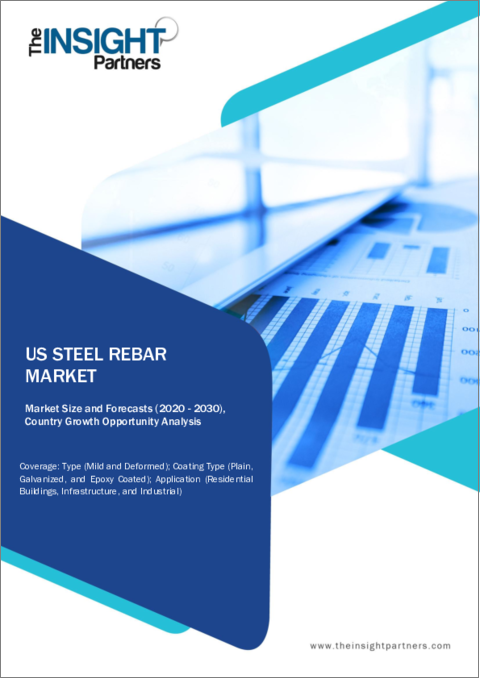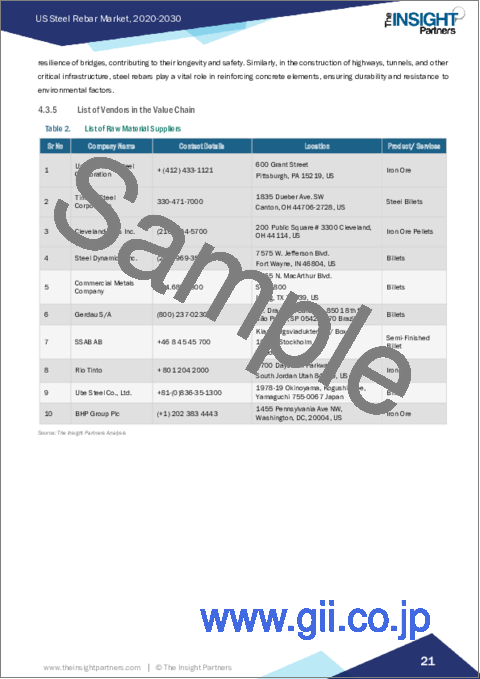|
|
市場調査レポート
商品コード
1408677
米国の鉄筋市場:規模・予測、地域シェア、動向、成長機会分析 - タイプ別、コーティングタイプ別、用途別US Steel Rebar Market Size and Forecasts, Regional Share, Trends, and Growth Opportunity Analysis Report Coverage: By Type, Coating Type, and Application |
||||||
|
|||||||
| 米国の鉄筋市場:規模・予測、地域シェア、動向、成長機会分析 - タイプ別、コーティングタイプ別、用途別 |
|
出版日: 2023年12月13日
発行: The Insight Partners
ページ情報: 英文 73 Pages
納期: 即納可能
|
- 全表示
- 概要
- 図表
- 目次
米国の鉄筋市場は2022年の206億7,000万米ドルから2030年には276億8,000万米ドルに成長すると予想され、2022年~2030年のCAGRは3.7%と予想されます。
鉄筋は、コンクリート構造物を補強・強化する建設業界の重要な部品です。通常、表面にリブ加工が施された高強度鋼は、強度を高めるためにコンクリート内に戦略的に配置されます。コンクリートは圧縮強度に優れていますが、引張強度には限界があり、引張状態ではひび割れを起こしやすいため、この補強は極めて重要です。鉄筋の設計には、柔軟性と強度の慎重なバランスが必要であり、これにより様々な構造荷重に耐えることができます。鉄筋表面のリブ模様は、周囲のコンクリートとの結合を強化し、滑りを防止して2つの材料間の効果的な荷重伝達を保証します。鉄筋の使用は、建設における材料間の相乗効果の証であり、コンクリートの圧縮強度と鋼鉄の引張強度を組み合わせることで、長期にわたって多様な環境条件や荷重に耐えることができる耐久性と弾力性のある構造体を作り出します。
住宅建設において、鉄筋はコンクリート基礎、柱、梁の補強に重要な役割を果たしています。鉄筋が提供する耐久性と強度は、住宅建築の寿命と構造的完全性を確保するために不可欠です。これは特に地震が多い地域では重要で、鉄筋に支えられた鉄筋コンクリート構造の使用は、厳しい安全基準を満たすために不可欠です。さらに、持続可能で弾力性のある建設方法を目指す動向は、鉄筋の需要をさらに後押ししています。建設業者やデベロッパーがエネルギー効率に優れ、環境に優しい住宅ビルの建設に重点を置く中、鉄筋を特徴とする鉄筋コンクリートの使用はこれらの目的に合致しています。鉄筋のリサイクル性と構造物の長寿命化能力は、住宅建設プロジェクトの全体的な持続可能性に貢献しています。住宅建設部門は、民間および米国政府の投資の増加により拡大しています。例えば、2021年には米国政府も手ごろな価格の住宅の提供に力を入れています。BBB計画の一環として、同政府は手頃な価格の住宅規定に1,500億米ドルの投資を割り当て、全国で100万戸以上の手頃な価格の住宅を建設・改修します。このような政府投資の増加は、住宅建設資材の需要を増加させ、米国鉄筋市場の成長を後押しすると予想されます。特に湿度の高い地域や海水に近い地域では、非腐食性の特性が建設資材においてますます重要になってきています。従来の鉄筋は腐食の影響を受けやすく、時間の経過とともに建物の構造的完全性を損なう可能性があります。非腐食性鉄筋の需要は、長寿命と耐久性を提供し、メンテナンスコストを削減し、その寿命にわたって構造物の安全性と安定性を確保するため、急増しています。従って、軽量、高強度、非腐食性の鉄筋に対する需要の高まりが米国鉄筋市場の成長を促進します。
さらに、鉄筋はコンクリート構造物に重要な補強を提供するため、住宅建築において重要な役割を果たしています。鉄筋は一般的に住宅の基礎に使用され、引張強度を高めるためにコンクリート内に戦略的に配置されます。この補強は、基礎が建物の構造荷重に耐えるのを助け、長期にわたる安定性と耐久性を保証します。鉄筋は、鉄筋コンクリートの柱や梁を構築するために住宅建設でよく使用されます。これらの要素は、建物の全体的な骨組みを支え、荷重を効率的に分散し、構造的な破壊を防ぎます。柱や梁に鉄筋を使用することで、風や地震、構造物の重量などの外力に対する建物の抵抗力に貢献します。
さらに、鉄筋は住宅内のスラブや床システムの建設にも応用されています。鉄筋コンクリートのスラブは、1階であろうと上層階であろうと、適切に配置された鉄筋が提供する追加的な強度と柔軟性から恩恵を受けます。住宅では、鉄筋コンクリートの壁に鉄筋が不可欠です。この用途は、壁の耐力と横方向の力に対する抵抗力を強化します。さらに、鉄筋はバルコニー、階段、その他の構造要素の建設にも使用され、住宅建物の全体的な安全性と完全性に貢献します。これらの住宅建設からの需要の急増は、米国の鉄筋市場の成長を促進すると予想されます。
米国鉄筋市場で事業を展開している主な企業は、Steel Edge Inc、InteRebar Fabricators LLC、JJ Rebar Corp、Pacific Steel Group、PJ's Rebar Inc、Integrity Rebar Placers、Nucor Harris Rebar Inc、Camblin Steel Services Inc、Northern Nevada Rebar Inc、Bellis Steel Co Incなどです。同市場で事業を展開する企業は、顧客の要求を満たすために高品質で革新的な製品の開発に非常に注力しています。
米国の鉄筋市場全体の規模は、一次情報と二次情報の両方を用いて導き出されました。徹底的な二次調査は、市場に関連する質的・量的情報を得るために、社内外の情報源を用いて実施しました。また、データを検証し、より分析的な洞察を得るために、業界関係者に複数の一次インタビューを実施しました。このプロセスの参入企業には、副社長、市場開拓マネージャー、マーケットインテリジェンスマネージャー、国内営業マネージャーなどの業界専門家と、米国鉄筋市場を専門とするバリュエーション専門家、調査アナリスト、キーオピニオンリーダーなどの外部コンサルタントが含まれます。
目次
第1章 イントロダクション
第2章 エグゼクティブサマリー
- 主要洞察
- 市場の魅力
- 米国市場魅力度 - 用途別
第3章 調査手法
- 調査範囲
- 2次調査
- 1次調査
第4章 鉄筋市場情勢
- ポーターのファイブフォース分析
- 供給企業の交渉力
- 買い手の交渉力
- 新規参入業者の脅威
- 企業間の競合関係
- 代替品の脅威
- 潜在顧客のリスト
- エコシステム分析
- 原材料サプライヤー
- メーカー
- 流通業者または供給業者
- 最終用途産業
第5章 米国の鉄筋市場:主要市場力学
- 市場促進要因
- 住宅建設セクターの成長
- 軽量、高強度、非腐食性鉄筋の需要増加
- 市場抑制要因
- 原材料価格の変動
- 市場機会
- インフラ整備への投資の増加
- 今後の動向
- 持続可能な製造プロセスの開発
- 影響分析
第6章 鉄筋市場:米国市場分析
- 鉄筋市場収益(キロトン)
- 鉄筋市場収益
- 鉄筋市場の予測と分析
第7章 鉄筋市場分析 - タイプ別
- 軟質
- 異形
第8章 鉄筋市場分析 - コーティングタイプ別
- プレーン
- 亜鉛メッキ
- エポキシ塗装
第9章 鉄筋市場分析 - 用途別
- 住宅
- インフラ
- 産業
第10章 COVID-19パンデミックの米国鉄筋市場への影響
- COVID-19前後の影響
第11章 業界情勢
- 市場イニシアティブ
第12章 競合情勢
- ヒートマップ分析 - 主要企業別
- 各社のポジショニングと集中度
第13章 企業プロファイル
- Steel Edge Inc
- InteRebar Fabricators LLC
- JJ Rebar Corp
- Pacific Steel Group
- PJ's Rebar Inc
- Integrity Rebar Placers
- Nucor Harris Rebar Inc
- Camblin Steel Services Inc
- Northern Nevada Rebar Inc
- Bellis Steel Co Inc
第14章 付録
List Of Tables
- Table 1. Steel Rebar Market Segmentation
- Table 2. List of Raw Material Suppliers
- Table 3. List of Manufacturers
- Table 4. Steel Rebar Market Volume and Forecasts To 2030 (Kilo Tons)
- Table 5. Steel Rebar Market Revenue and Forecasts To 2030 (US$ Billion)
- Table 6. Steel Rebar Market Revenue and Forecasts To 2030 (US$ Billion) -Type
- Table 7. Steel Rebar Market Volume and Forecasts To 2030 (Kilo Tons) - Coating Type
- Table 8. Steel Rebar Market Revenue and Forecasts To 2030 (US$ Billion) - Coating Type
- Table 9. Steel Rebar Market Revenue and Forecasts To 2030 (US$ Billion) - Application
- Table 10. Company Positioning & Concentration
List Of Figures
- Figure 1. Steel Rebar Market Segmentation, By Geography
- Figure 2. Porter's Five Forces Analysis
- Figure 3. Ecosystem: Steel Rebar Market
- Figure 4. Market Dynamics: Global Mancozeb Market
- Figure 5. Fluctuations in Iron Ore Prices from January 2019 to April 2023
- Figure 6. US Steel Rebar Market Impact Analysis of Drivers and Restraints
- Figure 7. Steel Rebar Market Revenue (Kilo Tons), 2020 - 2030
- Figure 8. Steel Rebar Market Revenue (US$ Billion), 2020 - 2030
- Figure 9. Steel Rebar Market Share (%) -Type, 2022 and 2030
- Figure 10. Mild Market Revenue and Forecasts To 2030 (US$ Billion)
- Figure 11. Deformed Market Revenue and Forecasts To 2030 (US$ Billion)
- Figure 12. Steel Rebar Market Share (%) - Coating Type, 2022 and 2030
- Figure 13. Plain Market Volume and Forecasts To 2030 (Kilo Tons)
- Figure 14. Plain Market Revenue and Forecasts To 2030 (US$ Billion)
- Figure 15. Galvanized Market Volume and Forecasts To 2030 (Kilo Tons)
- Figure 16. Galvanized Market Revenue and Forecasts To 2030 (US$ Billion)
- Figure 17. Epoxy Coated Market Volume and Forecasts To 2030 (Kilo Tons)
- Figure 18. Epoxy Coated Market Revenue and Forecasts To 2030 (US$ Billion)
- Figure 19. Steel Rebar Market Share (%) - Application, 2022 and 2030
- Figure 20. Residential Buildings Market Revenue and Forecasts To 2030 (US$ Billion)
- Figure 21. Infrastructure Market Revenue and Forecasts To 2030 (US$ Billion)
- Figure 22. Industrial Market Revenue and Forecasts To 2030 (US$ Billion)
- Figure 23. Heat Map Analysis By Key Players
The US steel rebar market is expected to grow from US$ 20.67 billion in 2022 to US$ 27.68 billion by 2030; it is expected to register a CAGR of 3.7% from 2022 to 2030.
Steel rebar is a critical component in the construction industry, reinforcing and strengthening concrete structures. The increasingly high-strength steel, typically with ribbed surfaces, is strategically placed within concrete to enhance strength. This reinforcement is crucial because concrete excels in compression but has limited tensile strength and is prone to cracking under tension. The design of steel rebar involves a careful balance of flexibility and strength, allowing it to withstand various structural loads. The ribbed patterns on the surface of the rebar enhance its bond with the surrounding concrete, preventing slippage and ensuring effective load transfer between the two materials. The use of steel rebar is a testament to the synergy between materials in construction, combining the compression strength of concrete with the tensile strength of steel to create durable and resilient structures capable of withstanding diverse environmental conditions and loads over time.
In residential construction, steel rebar plays a crucial role in reinforcing concrete foundations, columns, and beams. The durability and strength provided by steel rebar are essential for ensuring the longevity and structural integrity of residential buildings. This is particularly significant in regions prone to seismic activity, where the use of reinforced concrete structures supported by steel rebar is essential for meeting stringent safety standards. Additionally, the trend toward sustainable and resilient construction practices further supports the demand for steel rebar. As builders and developers focus on constructing energy-efficient and environmentally friendly residential buildings, the use of reinforced concrete featuring steel rebar aligns with these objectives. Steel rebar's recyclability and ability to enhance structures' longevity contribute to the overall sustainability of residential construction projects. The residential construction sector is expanding with growing private and US government investments. For instance, in 2021, the US government is also focusing on providing affordable housing. As part of the BBB plan, the government allocated an investment of US$ 150 billion on affordable housing provisions to construct and rehabilitate over 1 million affordable homes across the country. This increased government investment is expected to increase the demand for residential construction materials, which is expected to boost the US steel rebar market growth. Noncorrosive properties are becoming increasingly important in construction materials, especially in areas with high humidity or proximity to saltwater. Traditional rebars are susceptible to corrosion, which can compromise the structural integrity of a building over time. The demand for noncorrosive steel rebars has upsurged as they offer longevity and durability, reducing maintenance costs and ensuring the safety and stability of structures over their lifespan. Thus, the rising demand for lightweight, high-strength, and noncorrosive rebars drives the US steel rebar market growth.
Moreover, Steel rebars play a vital role in the construction of residential buildings as they provide crucial reinforcement to concrete structures. The rebars are commonly used in the foundation of homes, where they are strategically placed within the concrete to enhance its tensile strength. The reinforcement helps the foundation withstand the structural loads the building imposes, ensuring stability and durability over time. Steel rebars are often used in residential construction to construct reinforced concrete columns and beams. These elements support the overall framework of the building, distributing loads efficiently and preventing structural failure. Using rebars in columns and beams contributes to the building's ability to resist external forces, such as wind, earthquakes, and the structure's weight.
Moreover, steel rebars have applications in the construction of slabs and floor systems within residential buildings. Reinforced concrete slabs benefit from the added strength and flexibility provided by properly placed rebars, whether for ground floors or upper levels. In the context of residential buildings, steel rebars are essential in reinforced concrete walls. This application enhances the walls' load-bearing capacity and resistance to lateral forces. Additionally, rebars may be used in constructing balconies, stairs, and other structural elements, contributing to the overall safety and integrity of the residential buildings. Surging demand from these residential construction is expected to drive the US steel rebar market growth.
A few key players operating in the US steel rebar market are Steel Edge Inc, InteRebar Fabricators LLC, JJ Rebar Corp, Pacific Steel Group, PJ's Rebar Inc, Integrity Rebar Placers, Nucor Harris Rebar Inc, Camblin Steel Services Inc, Northern Nevada Rebar Inc, and Bellis Steel Co Inc. Players operating in the market are highly focused on developing high-quality and innovative product offerings to fulfill customers' requirements.
The overall US steel rebar market size has been derived using both primary and secondary sources. Exhaustive secondary research has been conducted using internal and external sources to obtain qualitative and quantitative information related to the market. Also, multiple primary interviews have been conducted with industry participants to validate the data and gain more analytical insights into the topic. The participants of this process include industry experts, such as VPs, business development managers, market intelligence managers, and national sales managers-along with external consultants, such as valuation experts, research analysts, and key opinion leaders-specializing in the US steel rebar market.
Reasons to Buy:
- Progressive industry trends in the US steel rebar market to help players develop effective long-term strategies
- Business growth strategies adopted by developed and developing markets
- Quantitative analysis of the US steel rebar market
- Estimation of the demand for steel rebar across various industries
- Porter’s five forces analysis provide a 36NA-degree view of the US steel rebar market
- Recent developments to understand the competitive market scenario and the demand for steel rebar in the US scenario.
- Market trends and outlook coupled with factors driving and restraining the growth of the US steel rebar market.
- Decision-making process by understanding strategies that underpin commercial interest concerning the US steel rebar market growth
- The US steel rebar market size at various nodes of market
- Detailed overview and segmentation of the US steel rebar market as well as its dynamics in the industry
- The US steel rebar market size in different regions with promising growth opportunities
Table Of Contents
1. Introduction
- 1.1 The Insight Partners Research Report Guidance.
- 1.2 Market Segmentation
2. Executive Summary
- 2.1 Key Insights
- 2.2 Market Attractiveness
- 2.2.1 Market Attractiveness for US, by Application
3. Research Methodology
- 3.1 Coverage
- 3.2 Secondary Research
- 3.3 Primary Research
4. Steel Rebar Market Landscape
- 4.1 Overview
- 4.2 Porter's Five Forces Analysis
- 4.2.1 Bargaining Power of Suppliers
- 4.2.2 Bargaining Power of Buyers
- 4.2.3 Threat of New Entrants
- 4.2.4 Intensity of Competitive Rivalry
- 4.2.5 Threat of Substitutes
- 4.3 List of Potential Customers
- 4.4 Ecosystem Analysis
- 4.4.1 Raw Material Suppliers:
- 4.4.2 Manufacturers:
- 4.4.3 Distributors or Suppliers:
- 4.4.4 End Use Industry:
5. US Steel Rebar Market - Key Market Dynamics
- 5.1 Market Drivers
- 5.1.1 Growing Residential Construction Sector
- 5.1.2 Increasing Demand for Lightweight, High Strength, and Noncorrosive Rebars
- 5.2 Market Restraints
- 5.2.1 Fluctuating Raw Material Prices
- 5.3 Market Opportunities
- 5.3.1 Increasing Investments in Infrastructure Development
- 5.4 Future Trends
- 5.4.1 Development of a Sustainable Manufacturing Process
- 5.5 Impact Analysis
6. Steel Rebar Market - US Market Analysis
- 6.1 Steel Rebar Market Revenue (Kilo Tons)
- 6.2 Steel Rebar Market Revenue (US$ Billion)
- 6.3 Steel Rebar Market Forecast and Analysis
7. Steel Rebar Market Analysis - Type
- 7.1 Mild
- 7.1.1 Overview
- 7.1.2 Mild Market Volume, Revenue and Forecast to 2030 (US$ Billion)
- 7.2 Deformed
- 7.2.1 Overview
- 7.2.2 Deformed Market Volume, Revenue and Forecast to 2030 (US$ Billion)
8. Steel Rebar Market Analysis - Coating Type
- 8.1 Plain
- 8.1.1 Overview
- 8.1.2 Plain Market, Volume, Revenue and Forecast to 2030 (Kilo Tons) (US$ Billion)
- 8.2 Galvanized
- 8.2.1 Overview
- 8.2.2 Galvanized Market, Volume, Revenue and Forecast to 2030 (Kilo Tons) (US$ Billion)
- 8.3 Epoxy Coated
- 8.3.1 Overview
- 8.3.2 Epoxy Coated Market, Volume, Revenue and Forecast to 2030 (Kilo Tons) (US$ Billion)
9. Steel Rebar Market Analysis - Application
- 9.1 Residential Buildings
- 9.1.1 Overview
- 9.1.2 Residential Buildings Market, Revenue, and Forecast to 2030 (US$ Billion)
- 9.2 Infrastructure
- 9.2.1 Overview
- 9.2.2 Infrastructure Market Revenue, and Forecast to 2030 (US$ Billion)
- 9.3 Industrial
- 9.3.1 Overview
- 9.3.2 Industrial Market Revenue and Forecast to 2030 (US$ Billion)
10. Impact of COVID-19 Pandemic on US Steel Rebar Market
- 10.1 Pre & Post Covid-19 Impact
11. Industry Landscape
- 11.1 Overview
- 11.2 Market Initiative
12. Competitive Landscape
- 12.1 Heat Map Analysis By Key Players
- 12.2 Company Positioning & Concentration
13. Company Profiles
- 13.1 Steel Edge Inc
- 13.1.1 Key Facts
- 13.1.2 Business Description
- 13.1.3 Products and Services
- 13.1.4 Financial Overview
- 13.1.5 SWOT Analysis
- 13.1.6 Key Developments
- 13.2 InteRebar Fabricators LLC
- 13.2.1 Key Facts
- 13.2.2 Business Description
- 13.2.3 Products and Services
- 13.2.4 Financial Overview
- 13.2.5 SWOT Analysis
- 13.2.6 Key Developments
- 13.3 JJ Rebar Corp
- 13.3.1 Key Facts
- 13.3.2 Business Description
- 13.3.3 Products and Services
- 13.3.4 Financial Overview
- 13.3.5 SWOT Analysis
- 13.3.6 Key Developments
- 13.4 Pacific Steel Group
- 13.4.1 Key Facts
- 13.4.2 Business Description
- 13.4.3 Products and Services
- 13.4.4 Financial Overview
- 13.4.5 SWOT Analysis
- 13.4.6 Key Developments
- 13.5 PJ's Rebar Inc
- 13.5.1 Key Facts
- 13.5.2 Business Description
- 13.5.3 Products and Services
- 13.5.4 Financial Overview
- 13.5.5 SWOT Analysis
- 13.5.6 Key Developments
- 13.6 Integrity Rebar Placers
- 13.6.1 Key Facts
- 13.6.2 Business Description
- 13.6.3 Products and Services
- 13.6.4 Financial Overview
- 13.6.5 SWOT Analysis
- 13.6.6 Key Developments
- 13.7 Nucor Harris Rebar Inc
- 13.7.1 Key Facts
- 13.7.2 Business Description
- 13.7.3 Products and Services
- 13.7.4 Financial Overview
- 13.7.5 SWOT Analysis
- 13.7.6 Key Developments
- 13.8 Camblin Steel Services Inc
- 13.8.1 Key Facts
- 13.8.2 Business Description
- 13.8.3 Products and Services
- 13.8.4 Financial Overview
- 13.8.5 SWOT Analysis
- 13.8.6 Key Developments
- 13.9 Northern Nevada Rebar Inc
- 13.9.1 Key Facts
- 13.9.2 Business Description
- 13.9.3 Products and Services
- 13.9.4 Financial Overview
- 13.9.5 SWOT Analysis
- 13.9.6 Key Developments
- 13.10 Bellis Steel Co Inc
- 13.10.1 Key Facts
- 13.10.2 Business Description
- 13.10.3 Products and Services
- 13.10.4 Financial Overview
- 13.10.5 SWOT Analysis
- 13.10.6 Key Developments






